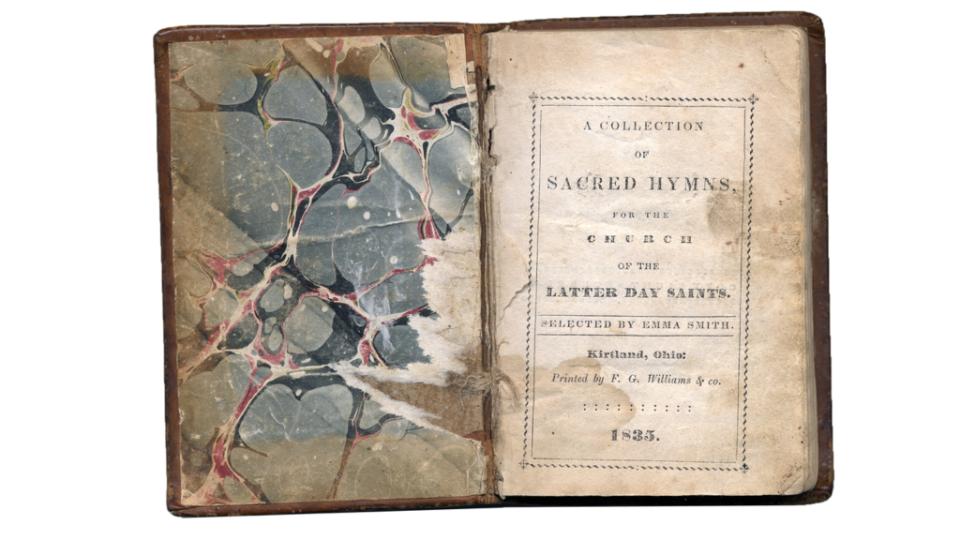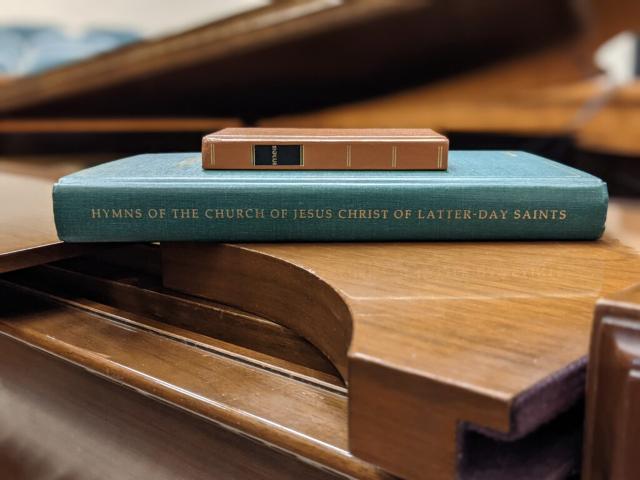
This story appears here courtesy of TheChurchNews.com. It is not for use by other media.
By Christine Rappleye, Church News
The call for hymns for an upcoming Latter-day Saint hymnal was simple, yet direct. And a woman named Hannah E. Adams sent in her submission of four sets of lyrics with the hope they could be useful for the new hymnal.
While Church leaders in 2018–2019 requested submissions for a revised hymnbook and new “Children’s Songbook,” Adams’ letter was sent in more than 175 years ago in 1843.
Adams, who lived in Andover, Ohio, wrote to Emma Smith in Nauvoo, Illinois, in response to the notice in the Times and Seasons newspaper on February 1, 1843, that called for “hymns adapted to the worship of the Church of Jesus Christ of Latter Day Saints.”
It’s one of the 96 documents amid those about legal, financial, administrative, judicial and real estate issues and several of the teachings of Joseph Smith at the time in “Joseph Smith Papers, Documents Vol. 12: March–July 1843,” which was released Monday, April 26.
By 1843, three hymnbooks had been published — two in the United States and one in England — and plans were in the works for another. However, it was never published.
For the hymnals published in the early days of the Church, there’s not much of a paper trail of hymn submissions, book drafts or publication manuscripts, said Robin Scott Jensen, a Church historian and one of the editors for “Documents, Vol. 12.”
“I think that this letter in particular is fairly unique in the sense that we have captured part of this process,” Jensen said.

Joseph-Smith-Papers-Hymns
Emma Hale Smith’s 1835 collection of sacred hymns included 90 hymns.2021 by Intellectual Reserve, Inc. All rights reserved.First Hymnbooks
In Doctrine and Covenants 25, Emma Smith is directed to “make a selection of sacred hymns.”
That wasn’t something that women typically did at the time, said Jenny Reeder, a Church historian who specializes in 19th century women’s history. “It was actually a comfortable, natural thing for her because she likes singing and grew up in a Methodist tradition.”
“Many of the songs from the book were included in that newspaper at different times,” Reeder said.
That press, which was also being used to publish the Book of Commandments, was destroyed in 1833 by mob violence. So, they had to start over on the project.
“Just like we need the revelations to guide the Church, we need the hymnal to help the Saints to worship God,” Jensen said.
That first hymnbook, titled “A Collection of Sacred Hymns, for the Church of the Latter Day Saints,” which had 90 hymns, had no music and fit into a pocket, was compiled in 1835 and published in time for the dedication of the Kirtland Temple in 1836.
Emma Smith drew on a variety of sources for hymns for that first hymnbook, which included 30 to 40 original Latter-day Saint songs.
“It really expands the community to include all these beautiful hymns and songs of truth that come from so many different faith traditions, and that includes Congregationalists and Baptists and Methodists, as well as Latter-day Saints,” Reeder said.
The next hymnbook Emma Smith compiled was published in 1841. And due to slow communication with the missionaries in England, Brigham Young had published a hymnbook in 1840 in England. Many of the British Saints brought that Manchester hymnal with them as they immigrated.
The Letter
“We can’t have hymns from Eliza R. Snow without Eliza R. Snow living the gospel and understanding what it meant for her. So, it’s the same here with Hannah Adams where we can see what she’s thinking about, what really prompted her faith,” Jensen said.
In the 1843 letter, Adams acknowledged that she and Emma haven’t met: “altho strangers to each other in the flesh yet I trust we have been made near to each other by being Baptised into one spirit.”
Her lyrics reflect going through trials but also receiving help from God.
“She’s writing hymns about how God can envelop us with grace and that God can help us through our trials, and it’s just wonderful to see that,” Jensen said.
Hannah Adams’ husband, James M. Adams, added a postscript at the end to Joseph Smith with an update on missionary work and about getting copies of the scriptures to the branch in Ohio, which is likely how it was filed with Joseph’s correspondence, Jensen said.
“It’s interesting that the wife is sending a letter to Emma with some hymns to compile the book and then the husband’s writing in saying they need books,” Jensen said.
Singing in the Church

Joseph-Smith-Papers-Hymns
Two girls sing from a Latter-day Saint hymnbook.2021 by Intellectual Reserve, Inc. All rights reserved.In addition to singing hymns at church meetings, hymns were sung in a variety of other settings.
"The hymnbook is this living, breathing book that we find in our worship service,” Jensen said.
When the Female Relief Society of Nauvoo would meet, it always recorded in the minutes the hymns sung, Reeder said. And there was one meeting where all they did was sing hymns, she added.
Hymns are sung at temple dedications. Joseph Smith requested a song in Carthage Jail. There are also many stories of the pioneers singing hymns around campfires, Jensen said. Eliza R. Snow, who wrote poetry and hymns, would write songs on pieces of paper and share them as the pioneers went west.
“We have all sorts of other hymnists that wrote hymns, that really were able to bring what they understood about the gospel and how it impacted their lives and how it affected them and their families and put that in text, and I think it’s wonderful,” Jensen said.
And the hymns also reflect what the Saints were focused on at the time.
“If you look at the hymns, you can see the doctrine that’s being taught by the Church at that time, and it’s really all about building Zion, and that’s the plan,” Reeder said of the 1835 hymnbook.
But that hope to build Zion in a specific place isn’t realized. “By the time Emma begins to compile the second hymnbook in 1841, [the hymns] have a different timbre,” Reeder said. “It’s more focused on Jesus Christ and on His grace, and you get a different collection of hymns.”
‘Documents, Vol. 12’
During these months in 1843, Joseph Smith is leading the Church, he’s sitting in on city council meetings, he’s a judge with the mayor’s court and municipal court, and he’s the head of the Nauvoo Legion, said David Grua, lead historian and one of the volume editors.
Also, it’s during this time that Orrin Porter Rockwell is arrested and Joseph is communicating with lawyers. Troubles in Missouri are still continuing as the government initiates another round of extradition in summer 1843.
The Church is growing, both in the United States and abroad, and sending missionaries to Russia and the Pacific Islands.
As trustee of the Church, Joseph is handling the Church’s assets, which include the Church’s land. The discourses that are later canonized as Doctrine and Covenants 130 and 131 are included as is the revelation on plural marriage that’s now section 132.
It’s also a time when he’s teaching the Saints. He’s become more comfortable with preaching, said Grua. “He wanted to be in front of the Saints almost every Sunday teaching them. ‘Documents, Vol. 12’ has accounts of more than 20 discourses that he’s delivered during these months.”
They are meeting in the unfinished temple, where the walls are about 10 feet tall, with a temporary floor and likely a temporary stand, Grua said.
“So he is trying to point them to say ‘we’re not only meeting within the rising temple walls, but you need to be preparing yourself for the temple once it’s completed,’” Grua said.
In the Joseph Smith Papers series, there are three more “Documents” volumes, and the fifth in the “Revelations and Translations” series that includes what’s left of the original Book of Mormon manuscript. All of the documents from this volume and from the Joseph Smith Papers project are online at josephsmithpapers.org. There are also series on Joseph’s legal papers and one that’s recently started on the financial records.
A Brief History of the Church’s Hymnbooks

JS-Papers-Hymns
A replica of the 1835 “A Collection of Sacred Hymns, for the Church of the Latter Day Saints” and a copy of the 1985 “Hymns of The Church of Jesus Christ of Latter-day Saints” lie on a piano on April 25, 2017. Photo by Christine Rappleye, courtesy of Church News.All rights reserved.1835: “A Collection of Sacred Hymns, for the Church of the Latter Day Saints,” compiled by Emma Smith, contained 90 hymns, 30-40 of them written by Latter-day Saints.
1840: “A Collection of Sacred Hymns, for The Church of Jesus Christ of Latter-day Saints, in Europe,” printed in Manchester, England, under the direction of Brigham Young, Parley P. Pratt and John Taylor.
1841: “A Collection of Sacred Hymns, for the Church of the Latter Day Saints,” selected by Emma Smith, contained 304 hymns.
1889: “Latter-Day Saints’ Psalmody,” under the direction of President John Taylor, the first large collection of hymns to include musical notation.
1908: “Songs of Zion” published through the Northern States Mission, based in Chicago.
1927: “Latter-Day Saint Hymns” is the result of the Church Music Committee that combined hymns from different publications into a volume.
1985: “Hymns of The Church of Jesus Christ of Latter-day Saints” is published; about 200 of the 304 hymns have been translated into various languages.
June 2018: Church announces revision to hymnbook and “Children’s Songbook.”
Source: “Hymns,” Church History Topics on churchofjesuschrist.org and Church News archives
Copyright 2021 Deseret News Publishing Company